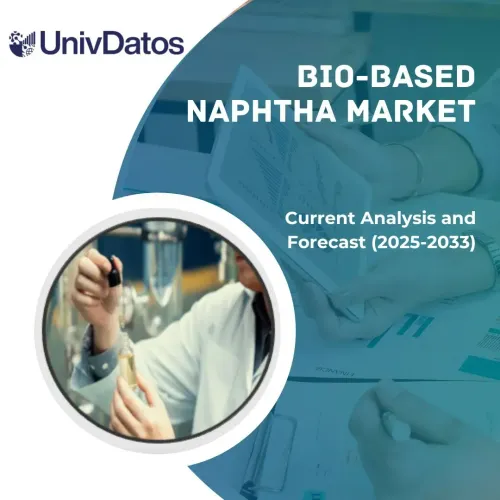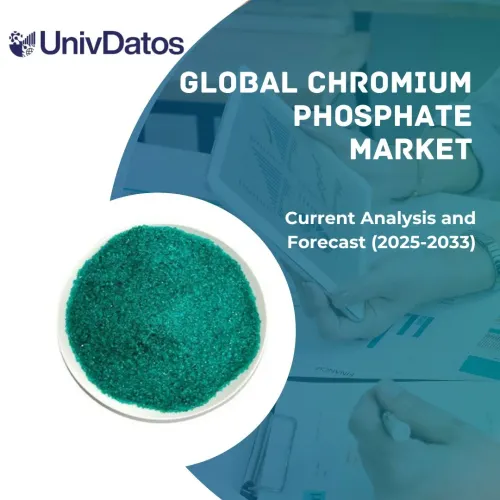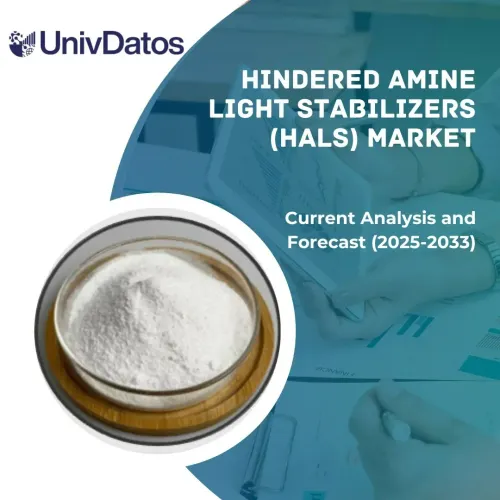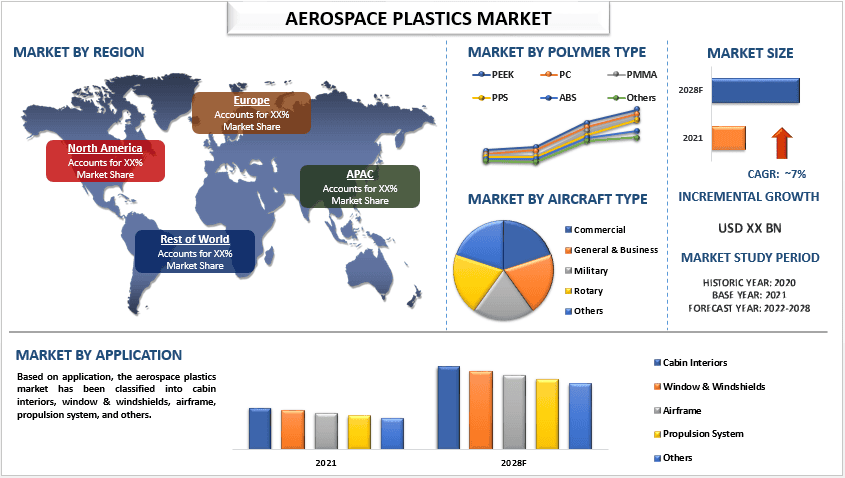
世界の航空宇宙用プラスチック市場は、予測期間中に約7%の顕著な成長率を示すと予想されています。航空宇宙用プラスチックは、航空機、宇宙船、衛星など、航空宇宙産業で使用される材料の一種として定義されています。これらの材料は、高い強度対重量比、低い熱膨張係数、高温と腐食に対する高い耐性、優れた機械的特性、燃料節約、ペイロード容量の向上、および性能の向上を目的として使用されています。さらに、航空宇宙用プラスチックには、熱可塑性樹脂、熱硬化性樹脂、複合材、エラストマーなど、幅広いポリマーベースの材料が含まれます。航空宇宙用プラスチックの一般的な例としては、炭素繊維強化ポリマー (CFRP)、アラミド繊維強化ポリマー (AFRP)、およびポリエーテルエーテルケトン (PEEK) やポリイミドなどの高温熱可塑性樹脂があります。さらに、軽量でより効率的な航空機に対する需要の高まりにより、航空宇宙用プラスチックの需要が増加しています。たとえば、2022年12月、リトアニアに拠点を置く航空電子機器会社であるWeSkyは、今週、新しい軽量の座席内電源システムを発表しました。 WeSky 60W USB電源ソリューションは「recharge」と呼ばれ、民間航空会社の燃料消費量を削減し、炭素排出量を削減できます。
SABIC; 三菱ケミカルグループ株式会社; サンゴバンS.A.; PPGインダストリーズ; デュポン; ソルベイ; エボニックインダストリーズAG; BASF SE; Victrex plc; Röchlingは、市場における主要プレーヤーの一部です。これらのプレーヤーは、ハイテクで革新的な製品/技術を顧客に提供するために、いくつかのM&Aとパートナーシップを実施しています。
レポートに提示された洞察
「ポリマータイプのうち、Polyetheretherketone (PEEK) カテゴリは、予測期間中に有意なCAGRで成長すると予想されています」
ポリマータイプに基づいて、市場はPolyetheretherketone (PEEK)、ポリカーボネート (PC)、ポリメタクリル酸メチル (PMMA)、ポリフェニレンスルフィド (PPS)、アクリロニトリルブタジエンスチレン (ABS)、およびその他に分類されます。 Polyetheretherketone (PEEK) カテゴリは、予測期間中に有意なCAGRで成長すると予想されます。これは主に、PEEKの特性、つまり高強度、軽量、耐薬品性、寸法安定性などによるものです。このような特性により、PEEKはブラケット、継手、ファスナーなどの構造部品の設計に使用されています。 PEEKは高い強度対重量比を持ち、高負荷と応力に耐えることができます。さらに、PEEKは、優れた電気絶縁特性により、コネクタや絶縁体などの電気部品の設計にも使用されており、高温に耐えることができます。したがって、このような要因がPEEKの需要を高めており、航空宇宙用プラスチック市場の成長を加速させることになります。
航空宇宙用プラスチック市場レポートの範囲
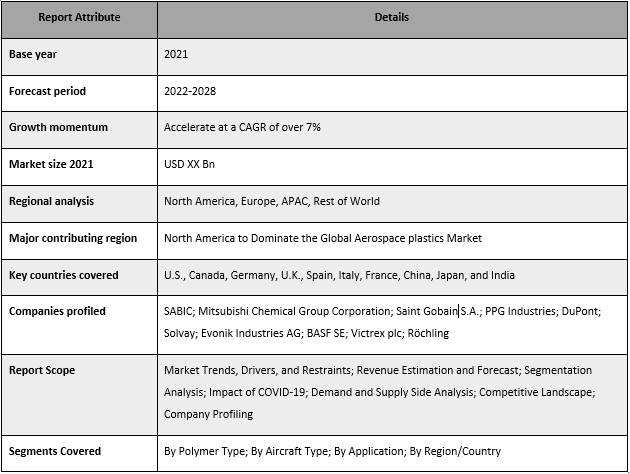
「航空機タイプのうち、軍用航空機は2021年に市場の大部分を占めると予想されています」
航空機タイプに基づいて、市場は民間、一般・ビジネス、軍用、回転翼、その他に分類されます。これらのうち、軍用航空機は、軍事航空宇宙におけるプラスチックの利用が多いことから、2021年に市場の大部分を占めると予想されます。これは主に、軽量プラスチックで重金属や合金を代替し、燃料効率と航続距離を向上させるためです。また、プラスチックは高い強度対重量比を提供するため、軽量でありながら高負荷と応力に耐えることができます。これにより、機体部品、着陸装置、エンジン部品などの構造部品に最適です。過酷な条件、つまり極端な温度、高い振動、化学物質や燃料への曝露に耐えることができます。したがって、軍用航空機における航空宇宙用プラスチックの需要の増加は、市場の成長を加速させています。
「北米は、予測期間中に市場をリードすると予想されています」
2021年には、北米が予測期間中に市場をリードすると予想されています。これは主に、ボーイング、ボンバルディア、エアバスなどの主要な航空機メーカーが、米国、カナダ、メキシコなどの国に生産施設とサプライヤーを置いていることによります。さらに、米国では、SABIC、Ensinger、Victrexなどの主要な航空宇宙用プラスチックメーカーが、外装パネル、客室インテリア部品、エンジン部品など、幅広いコンポーネントを製造しています。たとえば、2021年2月、ボーイングは、航空機部品の大手サプライヤーであるDiehl Aerospace GmbHとの契約を延長し、B787ドリームライナーのインテリア照明システムを供給しました。 Diehl Aerospaceは、航空機タイプのインテリア照明製品を継続的に改善しており、現在、新世代のLEDシステムを提供しています。さらに、カナダのメーカーは、民間および軍用航空機のさまざまなコンポーネントを製造しています。たとえば、複合構造の製造を専門とするComposites Atlanticや、航空業界向けの保護ケースを製造するPlasticaseなどの企業があります。
このレポートを購入する理由:
- この調査には、認証された主要な業界専門家によって検証された市場規模と予測分析が含まれています。
- このレポートは、業界全体のパフォーマンスを簡単にレビューします。
- このレポートは、主要な事業財務、製品ポートフォリオ、拡張戦略、および最近の開発に焦点を当てた、著名な業界ピアの詳細な分析を網羅しています。
- 業界で蔓延する推進要因、抑制要因、主要なトレンド、および機会の詳細な調査。
- この調査は、さまざまなセグメントにわたる市場を包括的にカバーしています。
- 業界の詳細な地域レベル分析。
カスタマイズオプション:
世界の航空宇宙用プラスチック市場は、要件またはその他の市場セグメントごとにさらにカスタマイズできます。これとは別に、UMIは、お客様が独自のビジネスニーズを持っている可能性があることを理解しており、お客様の要件に完全に適合するレポートを入手するために、お気軽にご連絡ください。
目次
航空宇宙用プラスチック市場分析(2022~2028年)のリサーチ方法論
世界の航空宇宙用プラスチック市場における航空宇宙用プラスチックの採用を作成および分析するために実施された3つの主要なステップは、過去の市場の分析、現在の市場の推定、および将来の市場の予測でした。過去の市場数値と現在の市場規模を推定するために、徹底的な二次調査が実施されました。次に、これらの洞察を検証するために、多数の調査結果と仮定が考慮されました。さらに、世界の航空宇宙用プラスチック市場のバリューチェーン全体にわたる業界専門家との徹底的な一次インタビューも実施されました。一次インタビューを通じて市場規模の仮定と検証の後、トップダウン/ボトムアップアプローチを採用して、完全な市場規模を予測しました。その後、市場の細分化とデータ三角測量方法を採用して、業界のセグメントとサブセグメントの市場規模を推定および分析しました。詳細な方法論を以下に説明します。
過去の市場規模の分析
ステップ1:二次資料の詳細な調査:
航空宇宙用プラスチック市場の過去の市場規模を取得するために、詳細な二次調査が実施されました。企業内部の情報源としては、年次報告書および財務諸表、業績発表、プレスリリースなど、および外部の情報源としては、ジャーナル、ニュース記事、政府刊行物、競合他社の刊行物、セクターレポート、第三者のデータベース、およびその他の信頼できる刊行物。
ステップ2:市場セグメンテーション:
航空宇宙用プラスチック市場の過去の市場規模を取得した後、主要地域におけるさまざまなセグメントとサブセグメントの過去の市場洞察とシェアを収集するために、詳細な二次分析を実施しました。主要なセグメントには、ポリマータイプ、航空機タイプ、および用途が含まれます。さらに、国レベルの分析を実施して、その地域におけるテストモデルの全体的な採用を評価しました。
ステップ3:要因分析:
さまざまなセグメントとサブセグメントの過去の市場規模を取得した後、詳細な要因分析を実施して、航空宇宙用プラスチック市場の現在の市場規模を推定しました。さらに、さまざまなポリマータイプ、航空機タイプ、および航空宇宙用プラスチックの用途などの従属変数と独立変数を使用して要因分析を実施しました。世界中の航空宇宙用プラスチック市場セクターにおける主要なパートナーシップ、合併と買収、事業拡大、および製品発売を考慮して、需要と供給側のシナリオについて徹底的な分析が実施されました。
現在の市場規模の推定と予測
現在の市場規模の算定:上記の3つのステップからの実用的な洞察に基づいて、現在の市場規模、世界の航空宇宙用プラスチック市場の主要プレーヤー、およびセグメントの市場シェアに到達しました。必要なすべてのパーセンテージシェア分割と市場の内訳は、上記の二次アプローチを使用して決定され、一次インタビューを通じて検証されました。
推定と予測:市場の推定と予測のために、推進要因とトレンド、抑制要因、およびステークホルダーが利用できる機会を含むさまざまな要因に重みが割り当てられました。これらの要因を分析した後、関連する予測手法、つまりトップダウン/ボトムアップアプローチを適用して、世界の主要市場におけるさまざまなセグメントとサブセグメントについて、2028年の市場予測に到達しました。市場規模を推定するために採用された調査方法論には以下が含まれます:
- 収益(米ドル)の観点での業界の市場規模、および主要市場における航空宇宙用プラスチック市場の採用率
- 市場セグメントとサブセグメントのすべてのパーセンテージシェア、分割、および内訳
- 提供される製品に関する世界の航空宇宙プラスチック市場の主要プレーヤー。また、急成長市場で競争するためにこれらのプレーヤーが採用した成長戦略
市場規模とシェアの検証
一次調査:主要地域全体で、トップレベルの幹部(CXO/VP、販売責任者、マーケティング責任者、運用責任者、地域責任者、カントリーヘッドなど)を含む主要オピニオンリーダー(KOL)との詳細なインタビューが実施されました。一次調査の結果が要約され、統計分析が実行されて、述べられた仮説が証明されました。一次調査からのインプットは二次的な調査結果と統合され、それによって情報が実行可能な洞察に変わりました。
さまざまな地域における一次参加者の内訳
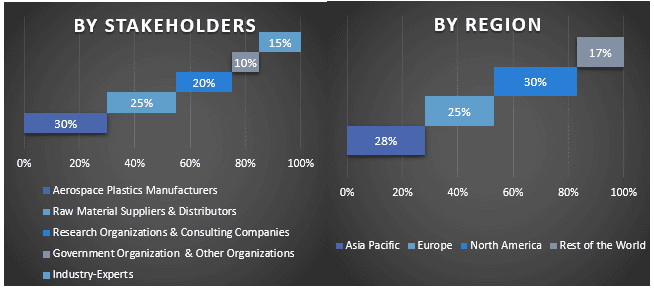
市場エンジニアリング
データ三角測量技術が、全体的な市場推定を完了し、世界の航空宇宙プラスチック市場の各セグメントとサブセグメントについて正確な統計数値を得るために採用されました。データは、ポリマーの種類、航空機の種類、および世界の航空宇宙プラスチック市場での用途の分野におけるさまざまなパラメータと傾向を研究した後、いくつかのセグメントとサブセグメントに分割されました。
世界の航空宇宙プラスチック市場調査の主な目的
この調査では、世界の航空宇宙プラスチック市場の現在および将来の市場動向が特定されました。投資家は、この調査で実行された定性的および定量的な分析に基づいて、投資に関する裁量権の根拠となる戦略的洞察を得ることができます。現在および将来の市場動向は、地域レベルでの市場全体の魅力を決定し、産業参加者が未開拓市場を利用して、ファーストムーバーの利点から利益を得るためのプラットフォームを提供しました。調査の他の定量的な目標には、以下が含まれます。
- 航空宇宙プラスチック市場の現在の市場規模と予測市場規模を金額(米ドル)で分析します。また、さまざまなセグメントとサブセグメントの現在の市場規模と予測市場規模を分析します
- 調査のセグメントには、ポリマーの種類、航空機の種類、および用途の分野が含まれます。
- 航空宇宙プラスチックの規制枠組みの定義と分析
- さまざまな仲介業者の存在に関連するバリューチェーンを分析し、業界の顧客と競合他社の行動を分析します。
- 主要地域における航空宇宙プラスチック市場の現在および予測市場規模を分析します。
- レポートで調査された地域の主要国には、アジア太平洋、ヨーロッパ、北米、およびその他の地域が含まれます。
- 航空宇宙プラスチック市場の企業プロファイルと、急成長市場で持続するために市場プレーヤーが採用した成長戦略
- 業界の詳細な地域レベル分析
関連 レポート
この商品を購入したお客様はこれも購入しました



